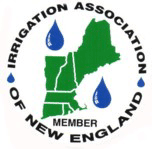
Call us at 603-428-7246 or 800-847-2583
 |
Call us at 603-428-7246 or 800-847-2583
|
 |
Troubleshooting Your Existing System Zone Run Times Because gear drive heads and sprayheads have different precipitation rates, they need to be run for differing lengths of time. This is also the reason they should never be mixed together on the same zone. In general, gear drive heads will put down about a quarter inch per hour, and sprayheads will put down an inch per hour. Our climate calls for about an inch of rain per week for healthy grass, so this would mean four hours of runtime for gear drive heads per week, and one hour for sprayheads per week. At a bare minimum, we recommend 30 minutes per zone on Hunter gear drive heads. As the weather gets hotter, this time will need to be increased to 45 minutes or even 1 hour. We run into people in the summer that complain of a brown lawn, but are running gear drive zones only 10 to 15 minutes in the morning, and the same in the evening. This is not the same as running it 30 minutes all at once, and certainly isn't enough water except in cool weather. We recommend that you put the water down anytime from midnight on. This allows all the water to soak into the ground, where the grass can use it. Watering under the hot sun causes not only evaporation, but transpiration as well. This is the act of the plant weeping moisture from the pores in the leaf as it grows. Since the dew sets at @ midnight anyway, the grass is already wet, so this won't cause any mold and mildew problems. Sprayhead zones throw an enormous amount of water in a short time. We recommend that these be run for 8 to 10 minutes in normal weather, and increased to 12 to 15 minutes in very hot weather. These heads can cause runoff under certain conditions, so be careful to check that this doesn't happen after 10 minutes or so. If it does, simply split the run time in half, and give it an hour or so in between run times for the water to soak in. The frequency of watering can also be altered. In the spring and fall months, every second or third day should be fine. All of our clocks have a "Skip Day" setting, allowing you to water every second, third, etc. day. If you are uncertain about this, check your timer manual. Watering every day in cool weather is unnecessary, and can actually cause problems. As the weather gets hotter, bring your schedule up to every day until the heat breaks. One trick I personally use is to add an extra program in very hot weather to run at 1:00 or 2:00 in the afternoon. This is just 3 to 5 minutes on sprayheads, and 12 to 15 minutes on gear drive heads. This is not to water the grass, but to give it a little cool off period in the hot part of the day. I learned this from an eccentric landscaper years ago, and it works! Never try to apply all the water needed at this time, as you can't generally put it down fast enough. Bear in mind that your own sun and soil conditions may dictate a different program than these outlined here. In general, these times will work for 99% of the lawns we have covered. Areas with a sand base and areas with a lot of trees may require more water than a heavily loamed lawn. Sandy soil should be watered in cycles, with a soak time in between, as opposed to all at once. Once you reach the saturation point, the water will simply run into the sand. Again, here is a good place to water twice, maybe again in mid morning, before the sun is to hot. Time and experience will tell you what works best in your own situation. |
|
|
|
Copyright© 2001 - 2023, Blue Sky Irrigation Systems Inc. All rights reserved.
|